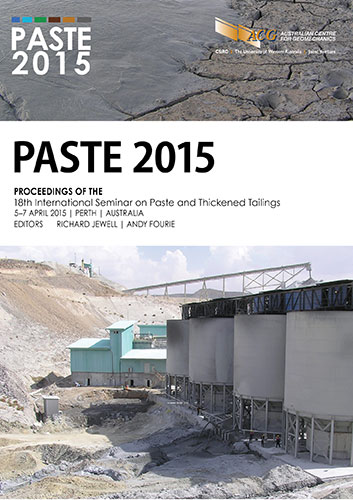Evaluation of the rheology of pipehead flocculated tailings

|
Authors: Slatter, PT; Seddon, KD |
DOI https://doi.org/10.36487/ACG_rep/1504_08_Slatter
Cite As:
Slatter, PT & Seddon, KD 2015, 'Evaluation of the rheology of pipehead flocculated tailings', in R Jewell & AB Fourie (eds), Paste 2015: Proceedings of the 18th International Seminar on Paste and Thickened Tailings, Australian Centre for Geomechanics, Perth, pp. 131-137, https://doi.org/10.36487/ACG_rep/1504_08_Slatter
Abstract:
Pipehead flocculation is now a realistic option for mining tailings dewatering and disposal. However, for beach slope prediction, it is of fundamental importance to gauge the impact that pipehead flocculation could have on the rheology of the agglomerated tailings material, and how this might change after extended periods of shear as the agglomerated material flows down the beach. To this end, the laboratory of ATC Williams was requested to conduct a programme of laboratory testing of mine tailings samples. The objective was to provide information on the rheological properties of pipehead flocculated tailings samples. For this exercise, two different tailings samples were used, and two different types of flocculants were used. The overall aim of the study was to obtain rheology for the purpose of predicting beach slopes. In order to achieve this, rheograms were obtained after varying time periods of sample pre-shear, so that any change in flow characteristics as the tailings flowed down the beach could be ascertained. For the first tailings material, for both flocculants, the rheological behaviour was essentially very similar for each test. Furthermore, there was no evidence of structural rebuild of the polymeric agglomerates. The second tailings sample material was sensitive to both flocculant type and shear history. This material showed evidence of structural rebuild of the polymeric agglomerates. Possible reasons for the fundamentally different behaviour are discussed. It is concluded that pipehead flocculation is a viable option, but needs to be evaluated for each material and flocculant type.
References:
Guang, R, Tshibang, M & Loayza, C 2014, ‘Application of in-line polymer addition for tailings disposal in Australia – learning and challenges’, in RJ Jewell, AB Fourie, PS Wells & D van Zyl (eds), Proceedings of the 17th international seminar on paste and thickened tailings, InfoMine, Vancouver, pp. 87-100.
Mizani, S, Simms, P, Dunmola, A, Côté, C & Freeman, G 2014, ‘Rheology for surface deposition of polymer-amended fine tailings’, in RJ Jewell, AB Fourie, PS Wells & D van Zyl (eds), Proceedings of the 17th international seminar on paste and thickened tailings, InfoMine, Vancouver, pp. 295-306.
Sofra, F, Fisher, DT & Boger, DV 2007, ‘The bucket rheometer for thickened tailings and paste flow curve determination’,
in AB Fourie & RJ Jewell (eds), Proceedings of the 10th international seminar on paste and thickened tailings, Australian Centre for Geomechanics, Perth, pp. 249-258.
Standards Australia 2006, AS 1289.3.5.1: Methods of testing soils for engineering purposes - Soil classification tests - Determination of the soil particle density of a soil - Standard method, Standards Australia, Sydney.
Standards Australia 2009a, AS 1289.3.1.2: Methods of testing soils for engineering purposes - Soil classification tests - Determination of the liquid limit of a soil - One point Casagrande method (subsidiary method), Standards Australia, Sydney.
Standards Australia 2009b, AS 1289.3.2.1: Methods of testing soils for engineering purposes - Soil classification tests - Determination of the plastic limit of a soil - Standard method, Standards Australia, Sydney.
Standards Australia 2009c, AS 1289.3.3.1: Methods of testing soils for engineering purposes - Soil classification tests - Calculation of the plasticity index of a soil, Standards Australia, Sydney.
Standards Australia 2009d, AS 1289.3.6.1: Methods of testing soils for engineering purposes - Soil classification tests - Determination of the particle size distribution of a soil - Standard method of analysis by sieving, Standards Australia, Sydney.
© Copyright 2025, Australian Centre for Geomechanics (ACG), The University of Western Australia. All rights reserved.
View copyright/legal information
Please direct any queries or error reports to repository-acg@uwa.edu.au
View copyright/legal information
Please direct any queries or error reports to repository-acg@uwa.edu.au